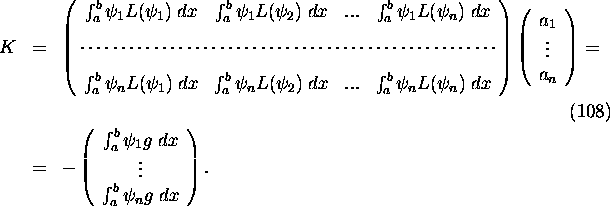In the Galerkin's method the functions Vi(x)
in (82) are defined as
![]()
Inserting (106) in (88) yields
![]()
The linear system (92) becomes

Example 1: We consider the two point boundary value
problem
![]()
![]()
The function g(x) and the differential operator L
are determined as
![]()
The two point boundary value problem (109)-(110)
has the exact solution
![]()
Next we approximate the solution of (109)-(110)
with trigonometric series
![]()
The boundary conditions (110) are satisfied
if
![]()
Taking n=2 in (113) we get approximation u* with
two terms as
![]()
Comparing (76) and (115) yields
![]()
Substituting ![]() and
and ![]() in (96) gives
in (96) gives ![]() linear system
linear system
![]()
According to the point
collocation method we choose the collocation points x1,
x2 and solve (117) with respect a1
and a2. For ![]() and
and ![]() one obtains
one obtains ![]() and
and
![]()
Subdomain collocation
method leads to the following solution
Taking ![]() (two subdomains with equal length) we can write the system (99)
as
(two subdomains with equal length) we can write the system (99)
as

The system (119) has solutions ![]() and therefore
and therefore
![]()
Let us use the least
square method now
For the present example the system (105)
reduces to

Solving (121) we get ![]() and
and
![]()
Galerkin's method gives
the following solution
For the considered example the system (108)
reduces to

Solving system (123) yields ![]() and therefore
and therefore
![]()
Comparison of solutions:

It is seen in Fig. 1., that the numerical results, obtained by four weighted residual methods are quite close to the exact solution. However, in present example only two terms in trigonometric series are considered.
Exercises
1. Solve the two point boundary value problem (109)-(110) taking n=3 and n=4. Compare results.